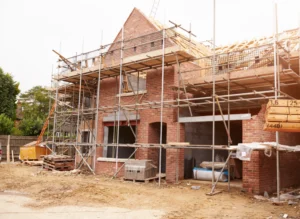
Software Development Timeline: How Long Does It Take To Build Custom Software?
By Thayer Tate
In this article, we describe the three main phases that a custom software project goes through, and the typical software development timeline. Understanding a typical custom software development timeline can help you make more informed and effective decisions for your business.
No two projects are alike or take the same amount of time to build. However, in our experience around 80% of the projects we work on fall into the software development timeline template presented below.
Are you considering building a custom software project and need a better understanding of the software development timeline and how long it takes? Keep reading to learn more!
Building Software is like Building a House

When planning and estimating a software engineering timeline and overall project, we consider each of the following phases separately:
- Requirements & Design
- Planning, Architecture & Development
- Software Testing
If you are familiar with building a custom home, the process for software is very similar. It is an analogy we use often.
The Requirements & Design phase equates to deciding on the type of house you want and then having an architect draw the blueprints for your home. At the end of this phase, you will have a concrete plan for your software application. At that point, all architecturally significant and budgetary impactful decisions should be made so that you can start the implementation with few to no surprises later.
Planning, Architecture & Development is the same as scheduling the contractors, pouring the foundation and constructing the house. In the case of software, a project manager schedules creative designers, technical architects, software engineers, etc.
The architects design the software foundation and framework, the creative designers create the user experience, and the software engineers make all the logic work. At the end of this phase, the application is fully built and you finally get to use it yourself.
Just like a house, before you can move in, you need to make sure the application meets certain standards. You can think of the last phase of the project, Software Testing, like the inspections, walk-throughs, and punch-out of a house.
A Typical Custom Software Development Schedule
Generally speaking, we can break down the software development timeline for a custom project as follows:
Requirements & Design: 2-4 Weeks
In software development, the Requirements & Design phase is predictable and short. As the decision maker and primary stakeholder, you will work with your chosen IT team to:
- Document the system requirements (the things that the software must accomplish)
- Collaborate on different ideas and application features that will work together to meet your system requirements
- Discuss your users, their capabilities, and the desired look and feel for the application
- Document and review the application design (your application blueprint) and discuss any last minute changes
- Decide on the initial scope of the project (what are the features you are building in the first release vs. later releases)
You can typically pencil in the Requirements & Design phase as a 2-4 week period on your software development timeline. The duration depends largely on the availability of you and your team, responsiveness to design reviews and questions, and how long it takes to make critical decisions.
Planning, Architecture & Development: 3-6 Months

Planning is the activity of laying out all the tasks in order, assigning the resources, and seeing which tasks can be done at the same time and which can’t.
For example, you can’t put the roof on until the framing is done. Similarly, you can’t hang the drywall until the plumbing and electricity are finished. Planning is a short activity performed prior to development work and typically lasts 2-3 days. However, it’s only one part of this phase.
Once planning is done, the system needs a framework or structure to build on. The technical architecture defines which technologies will be used and how they will work together.
Like planning, the technical architecture tends to be straightforward unless the project involves complex system integrations or incorporates complicated or unusual technologies. The architecture of a system takes anywhere between one to two weeks to develop. The exact timeline depends on the size of the system and its complexity.
The largest amount of time in software development is spent coding the application. Once the system is designed and the technical foundation is decided, we typically see the application built in 3-6 months.
This is perhaps the most exciting phase in the software development timeline for software development. It’s where your concept and the crucial design and planning work begin to transform into functional software.
If the software development timeline needs to be accelerated, the planning, architecture, and development phases are the most common phases in the project to do so. With multiple tasks to be accomplished, additional development resources can be added to speed up the effort.
At a certain point, however, the additional resources will cause a decrease in efficiency, leading to an increase in the software development timeline. That may sound counter-intuitive at first, but there’s a clear reason why that dropoff happens. It’s due to additional coordination and planning needed, not to mention the potential for developers and other stakeholders to step on each other’s toes.
Testing: 3-6 weeks
Depending on your project, there is a variety of testing that could and should be used. All projects should undergo end-to-end testing and user acceptance testing.
During development, features are tested in isolation but not as a unified whole. Once all of the software is developed, an end-to-end test exercises the system holistically and uses all of the features and functions of a system as the user would. This approach allows the tester to compare what was built to the original specifications and any changes in design made along the way.
A user acceptance test (UAT) is a period of time where you, the stakeholder, use the system and sign off on the development. You can consider it like a final walkthrough of a custom home. Your job is to look at everything, identify any issues that the testers may have missed, and start to get ready for production.
There are additional types of testing that you can elect to have done, such as cross-browser or cross-mobile-device testing, load testing, performance testing, and integration testing. If your application will be used on multiple browsers or mobile devices, you can choose to test on several different browsers/devices. This helps to ensure your application looks and works well on all browsers/devices that your user might choose.
If your application will have many users on the system at the same time, or will process a lot of data and must respond to the users within a certain time frame, load and performance testing should be considered. Load and performance testing makes sure that your application can handle heavy loads and identifies the slowest areas of your application for improvement, respectively.
Integration testing should be considered if your application will interact with third-party systems. Integration testing sends both expected and unexpected data through the connection of two systems. This testing process makes sure they handle all the known and unexpected permutations of data and situations (a timeout, a corrupted file, an invalid value, etc.) gracefully.
Depending on the size of your application and the extent of the testing needed, we see most testing efforts taking between 3-6 weeks.
Thinking About Your Software Development Timeline

So, how long does it take to develop software? Are you ready to start a new software development project? Work with our local team of software designers and developers or let us help you recruit a team of your own.
On average, we see a software development timeline of 4-9 months. The size and complexity of the project are the biggest factors in its overall duration. A project is considered large or has a greater complexity if any of the following apply:
- Involves 25+ screens
- Includes an administrative portal as well as a user application
- Supports multiple platforms (web, tablet, phone, iOS, Android, Windows Phone)
- Integrates with multiple systems (security systems, payment gateways, CRM systems, ERP systems, HR systems, etc.)
- Involves data migration from an older system
- Has complex business logic
- Has complex reporting requirements
- Involves a data warehouse or data mart
The following are a few other factors that can impact software development timelines. Part of the job of a Project Manager is to monitor these types of risks so they can be identified early and mitigated to keep the project on track.
- Change of requirements or design after the project has started
- Delays when working with third -parties such as not receiving technical documentation, credentials to test systems, or support on technical questions
- Missing requirements or unclear system design
- Inconsistent direction from multiple stakeholders
- Working with new technologies
- Fixing bad data or missing data in a data migration
Frequently Asked Questions:
How is software developed?
Developing software primarily involves software developers writing code. However, there are other important steps involved in the software development timeline, such as research, design, and project planning, to ensure the software aligns with user needs and evolves efficiently. Additionally, rigorous testing, version control, and documentation contribute to the overall reliability and success of the product.
What is a “build” in software testing?
A “build” refers to a version of a software application that is ready for testing. It is a compiled and assembled version of the software that incorporates the latest changes or additions to the codebase.
How to develop a software project step by step?
The software development timeline for a project involves several key steps, but the specific process can vary depending on the project’s methodology and nature. Nonetheless, the step-by-step process may involve the following steps:
- Project scope and objectives definition
- Architecture design
- Prototyping (optional)
- Development (coding)
- Deployment and Maintenance
How does software implementation contribute to the overall growth of an organization?
Software implementation is essential for overall organizational growth as it optimizes operational processes and enhances productivity. This allows the organization to adapt more successfully to industry changes and gain a competitive advantage in a highly evolving business environment.
Do SOLTECH’s custom software application development services cater to businesses with unique processes?
Yes. We understand that every business is unique, and a single software solution cannot solve every need. Therefore, we use a tailored approach to create a custom software development timeline that aligns seamlessly with each user’s unique workflows and requirements.
How long does it take to build a database?
A database is essentially one component of a software program. As such, the software development timeline for a database will typically take 4-6 months to build a database, which is the average timeline of software development. Simple databases may take a software development timeline of a few weeks, while more complex and large-scale databases can require several months or even years of development and refinement.
The Checklist For Sharing Your Software Vision
Before you get started in developing your software app, your thoughts and ideas should be clarified and written down so they can be consistently and easily shared and understood. We have created a checklist to help you get started on the right foot.
You can grab a copy of that checklist below and share it with your team!
Gain a competitive advantage in your industry with custom software development services from SOLTECH.
Thayer Tate
Chief Technology Officer Thayer is the Chief Technology Officer at SOLTECH, bringing over 20 years of experience in technology and consulting to his role. Throughout his career, Thayer has focused on successfully implementing and delivering projects of all sizes. He began his journey in the technology industry with renowned consulting firms like PricewaterhouseCoopers and IBM, where he gained valuable insights into handling complex challenges faced by large enterprises and developed detailed implementation methodologies.
Thayer is the Chief Technology Officer at SOLTECH, bringing over 20 years of experience in technology and consulting to his role. Throughout his career, Thayer has focused on successfully implementing and delivering projects of all sizes. He began his journey in the technology industry with renowned consulting firms like PricewaterhouseCoopers and IBM, where he gained valuable insights into handling complex challenges faced by large enterprises and developed detailed implementation methodologies.
Thayer’s expertise expanded as he obtained his Project Management Professional (PMP) certification and joined SOLTECH, an Atlanta-based technology firm specializing in custom software development, Technology Consulting and IT staffing. During his tenure at SOLTECH, Thayer honed his skills by managing the design and development of numerous projects, eventually assuming executive responsibility for leading the technical direction of SOLTECH’s software solutions.
As a thought leader and industry expert, Thayer writes articles on technology strategy and planning, software development, project implementation, and technology integration. Thayer’s aim is to empower readers with practical insights and actionable advice based on his extensive experience.



